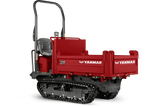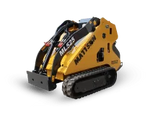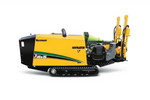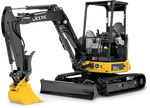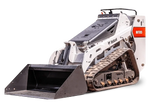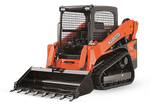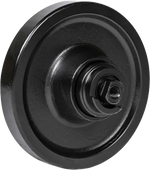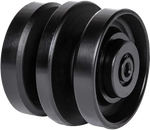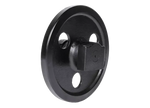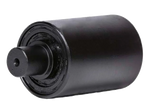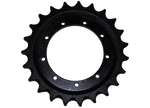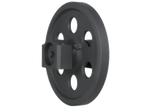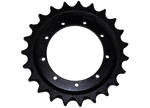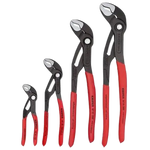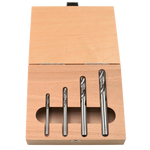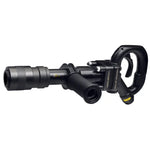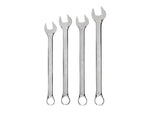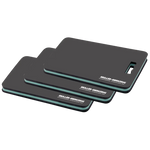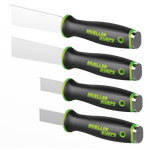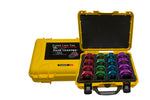John Deere 60G Review
Written by Luis Montes Updated On June 22, 2024

The John Deere 60G is pretty much a scaled-up version of the 35G mini excavator.
Our 35G review article delves deep into that particular piece of equipment, giving you an overall idea of what to expect from the 60G compact excavator without certain drawbacks, such as hydraulic functions stalling.
We’ll briefly and objectively check the pros and cons of the 60G and see how it differs from the 35G (besides the noticeable size difference) and similar mini excavators from other brands.
A Bigger, Better, and Stronger Compact Excavator

Photo source: www.ritchielist.com.
The 60G compact excavator is stronger than the 35G, as you would expect from the bigger end of an excavator series.
Compared to the 35G mini excavator, the John Deere 60G has 50% more bucket breakout force and 250% more over the front lifting capacity, to name a few facts. The power gap is partly due to a bigger engine and its related components, hence the bigger size of the 60G’s compartments.
The 35G and 60G have naturally aspirated Yanmar engines.
A naturally aspirated engine uses atmospheric pressure to suck air in for its internal combustion instead of relying on additional help as turbocharged engines do.

Heavy equipment with turbocharged engines can develop more power without significantly increasing the engine’s size, thanks to a turbocharger (pump) forcing more air into the combustion chamber.
On the other hand, to get more HP from a vehicle with a naturally aspirated engine, you must increase the engine’s size, as in the case between the 35G and 60G.
In addition to a bigger engine, the hydraulic system changed from an open-center valve with two variable displacement and a fixed gear pump to a closed-center load-sensing valve with one variable displacement pump.
The 35G’s open-center valve is why it stalls when using multiple hydraulic functions (as we mentioned in our article review).
In an open-center valve system, oil continuously flows through all the valves (in series) and back to the reservoir tank.
When you operate a valve, the incoming oil diverts to its serving cylinder. The return oil from the cylinder goes through the return line and onto the next valve. Operating a valve will affect the oil flow to the downstream valves, reducing the available fluid and their performance.
Our Kubota SVL97-2 review focused more on these hydraulic systems (animation included) regarding the hydraulic improvement between the SVL90 and the SVL95-2 models.
Lastly, thanks to the DPF filter and because the exhaust pipe on the 60G compact excavator points upward, you don’t see soot leaking out of the tailpipe as you do on the 35G.
The Pros of the John Deere 60G

Photo source: www.ritchielist.com.
Because of its bigger engine and high-performance hydraulic system, the 60G handles mulcher attachments efficiently, and its thumb is powerful and wide enough to take down pretty good-sized trees.
The 60G is fuel efficient. In an 8-hour average workday, you can burn 18 gallons out of the 31 gallons of tank capacity.
The AC system on this compact excavator is great. It blasts like a Ford truck.
Thanks to its larger compartments, the 60 G’s engine, hydraulic, and fill components are easier to access than on the 35G. The 60G’s bigger dimensions also allow designers to add a toolbox between the cab and the fuel inlet compartment.
Because of the rearrangement of some pillars, the 60G’s rear window is bigger than the 35G’s, and the back left pillar is out of the field of view, improving the machine’s rear visibility.

Besides the above, the 60G shares the features we found great about its smaller versions:
- A front roll-up window lets you work with the door open to get fresh air or communicate with co-workers.
- Big and nicely distributed tie-down lugs.
- There’s no need to ‘’arm the thumb’’ whenever you need to use it.
- Lockable hatches.
- Visible hydraulic oil sight glass.
- Stickers showing the service intervals and lifting capacities.
The Cons of the 60G Compact Excavator

Photo source: www.tractorbynet.com/forums.
Like the 35G, the 60G’s display panel is rudimentary, and the kill switch to mute the backup beeper resets whenever the levers are neutral.
We’d like a hydraulic “cruise mode” switch on the 60G. When running a mulcher or other hydraulic attachments, you gotta hold the trigger down or push the roller on the right lever. After a few hours, this will lead to hand fatigue.
A heads up for energy drink lovers: the cup holder is too big to hold them properly. It’ll hold a McDonald’s cup or something about that size, but not energy drinks.
Although not a bad thing per se, John Deere 60G owners may need a CDL (commercial driver’s license) to haul this compact excavator, even when doing so for non-business purposes—laws and regulations vary from state to state.
Let’s briefly cover the main technical reasons (we won’t cover additional endorsements and restrictions) for which you may need a CDL for this particular piece of equipment.
To haul a John Deere 60G, you’ll need a combination of truck and trailer similar to the following:
(We chose the below trucks and trailers randomly, just for the sake of understanding CDL requirements)
- Ford F-350 Super Duty + BigTex 22GN Tandem Dual Wheel Gooseneck Trailer.
- GMC Sierra 3500HD + PJ Trailers Classic Flatdeck with Duals (FD) 25’.
- Ram 3500 Heavy Duty + Kaufman 21000 GVWR Deluxe Equipment Tilt Trailer.
According to the FMCSA (Federal Motor Carrier Safety Administration), the trucks above have a GVWR (Gross Vehicle Weight Rating) greater than 10,001 lb. Therefore, they are defined as CMVs (Commercial Motor Vehicles).
To drive a CMV, you’ll need a CDL. There are three CDL classes according to the FMCSA (see picture below):

Based on the FMCSA CDL requirements and the GVWRs of our selected trucks and trailers, you’ll need a class A CDL, as you can see in the following table:
| EQUIPMENT | |||
|---|---|---|---|
| Model | Operating weight (lb) | ||
| John Deere 60G Mini Excavator | 13,620 | ||
| TRAILERS | |||
| Model | Payload (lb) (Greater than the 60G's operating weight) |
Curb weight (lb) | |
| BigTex 22GN Tandem Dual Wheel Gooseneck Trailer |
15,780 | 8,120 | |
| PJ Trailers H7 10" Pro-Beam Super-Wide Equipment |
16,600 | 6,240 | |
| Kaufman Deluxe 24K GVWR Tandem Dual Gooseneck Trailer |
20,000 | 5,900 | |
| TRUCKS | |||
| Model | Total weight to haul (lb) (Equipment + trailer) |
Towing capacity (lb) (Greater than total weight to haul) |
|
| Ford F-350 Super Duty - 6.7L Power Stroke Turbo Diesel with regular cab |
21,740 | 24,800 | |
| GMC Sierra 3500HD – 4WD SRW, diesel | 19,860 | 21,500 | |
| Ram 3500 Heavy Duty Limited Crew Cab 8' Box 4x4 |
19,520 | 19,870 | |
| CDL REQUIREMENTS | |||
| GVWR #1 / truck (lb) | GVWR #2 / trailer (lb) | GCWR = GVWR #1 + GVWR #2 | CDL required |
| Ford F-350 / 13,506 | BigTex / 23,900 | 37,406 | Class A |
| GMC Sierra / 11,800 | PJ Trailer / 23,000 | 34,800 | Class A |
| Ram 3500 / 11,400 | Kaufman / 24,000 | 35,400 | Class A |
Specifications of the 60G Compact Excavator
Even though it’s on the bigger end of the G series mini excavators, the 60G’s reduced tail swing design maximizes maneuverability and performance in tight spaces, making it perfect for “dig-and-go” projects.
General Specs
| Model | 60G with Long Arm, Cab, Extra Counterweight, and Rubber Tracks (For additional information, click the link below to check the entire brochure) |
||
|---|---|---|---|
| Engine | Model | Yanmar 4TNV98C-WHB | |
| Net Power - HP (kW) / rpm | 53 (39.6) / 2,000 | ||
| Hydraulic system * | Flow of auxiliary hydraulics - GPM (l/min) | 24.2 (91.5) | |
| Powertrain | Travel speed - mph (km/h) | Low | 1.8 (2.9) |
| High | 3.0 (4.8) | ||
| Tumbler distance - ft. in. (mm) ** | 6 ft. 6 in. (1,990) | ||
| Ground contact pressure - psi (kPa) | 5.2 (36) | ||
| Swing system | Swing speed - rpm | 9.5 | |
| Boom swing angle - degrees | Right | 60 | |
| Left | 80 | ||
| Operating weight (Including operator’s weight @ 175 lbs) - lbs (kg) |
13,690 (6,210) | ||
| Operating Dimensions | |||
| A | Maximum cutting height | 20 ft. 4 in. (6,190 mm) | |
| B | Maximum dumping height | 14 ft. 6 in. (4,410 mm) | |
| C | Maximum digging depth | 13 ft. 6 in. (4,120 mm) | |
| D | Maximum digging reach | 21 ft. 6 in. (6,560 mm) | |
| E | Minimum front swing radius | 8 ft. 4 in. (2,540 mm) | |
| F | Transport length | 19 ft. (5,790 mm) | |
| Machine Dimensions | |||
| G | Upper structure width | 6 ft. 4 in. (1,930 mm) | |
| H | Transport height | 8 ft. 4 in. (2,540 mm) | |
| I | Track width | 16 in. (400 mm) | |
| J | Undercarriage width | 6 ft. 7 in. (2,000 mm) | |
| K | Ground clearance | 13 in. (335 mm) | |
| L | Tail swing radius | 4 ft. 8 in. (1,410 mm) | |
| M | Engine cover height | 5 ft. 3 in. (1,600 mm) | |
| N | Maximum blade lift above ground | 18 in. (450 mm) | |
| O | Maximum blade drop below ground | 15 in (390 mm) | |
| P | Sprocket center to idler center (tumbler) | 6 ft. 6 in. (1,990 mm) | |
| Q | Undercarriage length | 8 ft. 2 in. (2,500 mm) | |
| R | Counterweight clearance | 24 in (620 mm) | |
| Lift Capacities | |||
| Attachment on ground level and arm with a reach radius of 10 ft - lb. (kg) | Over front | Over side | |
| 8,400 (3,810) | 3,700 (1,680) | ||
* Closed center load sensing with 1 variable displacement pump.
** The tumbler distance is the measurement between the centers of the front idler and the sprocket on the tracks. It affects the machine’s stability and operation.
Link to the complete brochure.

Image source: www.deere.com

Standard Features and Some Under the Radar
Like many mini excavators, the 60G also features technologies for improved fuel economy, such as auto-idle, which automatically reduces engine speed when you aren’t using hydraulics, auto shutdown if the machine is left idle for a set time, and the power/economy modes.
The power/economy modes also limit the 60G RPMs, impacting fuel consumption. The power mode is suitable for heavy tasks, while the economy mode is for lightweight tasks or transportation.
The John Deere 60G also features an auto speed change system for safe travel. It slows down the track speed whenever carrying a heavy load (according to the sensors). When the load “normalizes,” the tracks return to high speed.
A turtle speed lock switch locks the excavator into a low-speed mode, enhancing precision and control during delicate operations or working in confined spaces.
Telematics is becoming essential to the heavy equipment industry, and the 60G isn’t an exception. The JDLink connectivity service provides remote diagnostics and support. Know your machine location, get data to monitor machine health, and receive alerts to help you maximize productivity and efficiency.

However, some of the features of the 60G might go unnoticed. Check these out:
- A one-inch steel plate between the boom and arm.
- One-inch steel plates reinforce the boom base.
- A single-pin swing post reduces wear and strengthens the boom base joint (see image above).
- Porous oil-impregnated bushings. If you forget to lubricate a grease zerk, the oil inside the bushings secretes oil to lubricate things and prevent friction damage.
We highlight the first three features because most competitors use cast-iron plates instead of steel and dual-pin systems to swing the post, which takes us to the next section of this review.
The 60G vs the Competition

Photos source: www.ritchielist.com
| JOHN DEERE 60G COMPARED AGAINST THE COMPETITION (WITH CAB, RUBBER TRACKS, AND STANDARD ARM) |
|||||
|---|---|---|---|---|---|
| Model | John Deere 60G | Kubota KX057-5 | Bobcat E60 | Cat 305.5E2 | Takeuchi TB260 |
| PERFORMANCE | |||||
| Tail Swing | Reduced | Conventional | Conventional | Reduced | Conventional |
| Operating Weight - lb (kg) | 13,609 (6,173) | 12,577 (5,705) | 12,315 (5,586) | 11,958 (5,423) | 12,125 (5,735) |
| Max Dig Depth | 13 ft. 6 in. (4,115 mm) |
12 ft. 9 in. (3,875 mm) |
13 ft. 0.7 in. (3,981 mm) |
12 ft. 8 in. (3,861 mm) |
12 ft. 9.4 in. (3,895 mm) |
| Max Dump Height | 14 ft. 6 in. (4,420 mm) |
13 ft. 8 in. (4,155 mm) |
14 ft. 3.1 in. (4,347 mm) |
13 ft. 5 in. (4,089 mm) |
13 ft. 10.1 in. (4,220 mm) |
| Max Digging Reach | 21 ft. 6 in. (6,553 mm) |
20 ft. 7 in. (6,260 mm) |
20 ft. 6.3 in. (6,256 mm) |
20 ft. 3 in. (6,172 mm) |
20 ft. 6.9 in. (6,270 mm) |
| Max Bucket Digging Force - lb (kg) | 9,237 (4,190) | 10,172 (4,614) | 10,261 (4,654) | 11,443 (5,190) | 12,756 (5,786) |
| Max Arm Digging Force - lb (kg) | 6,063 (2,750) | 5,463 (2,478) | 6,446 (2,924) | 5,575 (2,529) | 5,755 (2,610) |
| ENGINE | |||||
| Net Power - hp (kW) | 53 (39.6) | 45.5 (33.9) | 55.7 (31.6) | 45.7 (34.1) | 47.6 (35.5) |
| UNDERCARRIAGE | |||||
| Ground Pressure - psi (kPa) | 5.1 (35) | 4.7 (32.2) | 4.6 (31.6) | 4.7 (32.2) | 4.6 (31.5) |
| Travel Speed Low Range - mph (km/h) |
1.8 (2.9) | 1.8 (2.8) | 1.7 (2.8) | 1.7 (2.8) | 1.7 (2.8) |
| Travel Speed High Range - mph (km/h) |
3.0 (4.8) | 3.1 (4.9) | 2.8 (4.5) | 2.8 (4.6) | 3.0 (4.9) |
| HYDRAULIC SYSTEM | |||||
| Auxiliary Hydraulic Flow - gpm (L/m) |
24.2 (92) | 19.8 (75) | 20 (75.7) | 21.1 (80) | 27 (102.2) |
| DIMENSIONS | |||||
| Width | 6 ft. 7 in. (2,007 mm) |
6 ft. 5 in. (1,960 mm) |
6 ft. 6 in. (1,981 mm) |
6 ft. 6 in. (1,981 mm) |
6 ft. 6.7 in. (2,000 mm) |
| Heigh | 8 ft. 4 in. (2,540 mm) |
8 ft. 4 in. (2,550 mm) |
8 ft. 4 in. (2,540 mm) |
8 ft. 4 in. (2,540 mm) |
8 ft. 5.4 in. (2,575 mm) |
| Length (Transport) | 19 ft. 4 in. (5,893 mm) |
18 ft. 1 in. (5,520 mm) |
18 ft. 5 in. (5,613 mm) |
17 ft. 11 in. (5,460 mm) |
18 ft. 2.5 in. (5,550 mm) |
The above machines have good-sized compartments for easy access and service to components, except for the Cat 305.5E2, which doesn’t have much room to work.
The 60G and the TB260 have basic display panels, while the KX057-5 and the Cat 305.5E2 have LCD screens. The Bobcat E60 has the upper hand with its touchscreen panel, which includes radio and Bluetooth functions.
The Bobcat design offers the largest foot and leg room. The E60 has only two pedals, which you can flip up to move out of the way when not in use. The Cat 305.5E2 also has two pedals, but they are not foldable.
John Deere and Kubota mini excavators have three pedals. Two foldable pedals drive the machine, and the third swings the boom. The Takeuchi TB260 has what we thought to be a fourth pedal, but it actually is a footrest.
The E60 is the only compact excavator in this group, with electronic over hydraulic controls. The other machines have 100% pilot controls. Pilot control levers enable a smoother and more responsive operation than electronic over hydraulic.
Kubota, Cat, and Takeuchi offer standard sizes for the arms of their mini excavators. The 60G has an optional long arm, while the E60 has an optional extendable arm for up to 30’’ extra reach.
Regarding performance, the 60G and the Cat 305.5E2 have 4 and 5 single-flanged bottom rollers, respectively. The E60 and KX057-5 have 5 dual-flanged track rollers for improved stability when slewing and digging over the side. The Takeuchi TB260 features 5 triple-flanged track rollers for increased roller-to-rail contact, improving track retention.
Testimonials and Real-Life Projects
The 60G’s mix of power and versatility has boosted its popularity, leading some equipment rental companies to add more units to their fleets. One such company is Rent1USA, which purchased three brand-new 60Gs to meet the high demand.
Besides landscaping and excavation jobs, the John Deere 60G is the perfect machine for demolition projects, such as barns and garages, as you can see in the following time-lapse videos:
Videos source: www.youtube.com/@healysllc8381
Wrapping Up
The 60G’s lifting capacity, breakout power, and mid-sized frame make it a great choice for handling heavy loads in commercial or residential excavation and landscaping jobs with spatial restrictions.
To take your landscape or construction company to the next level, pair the 60G with a smaller excavator like the John Deere 35G or the Kubota KX040 to reach areas the 60G compact excavator cannot.





